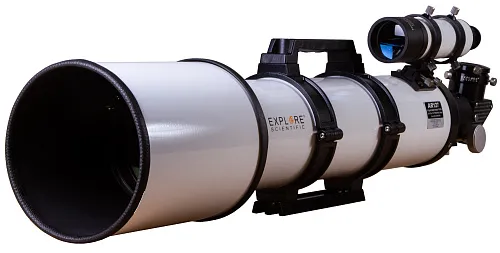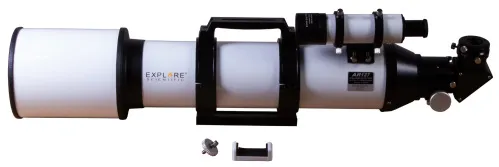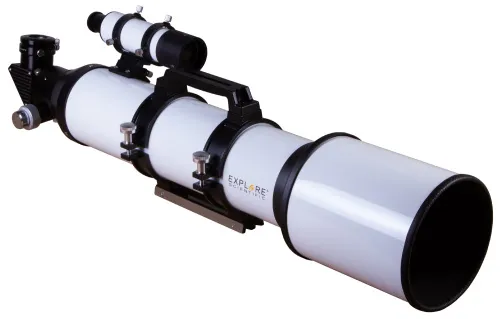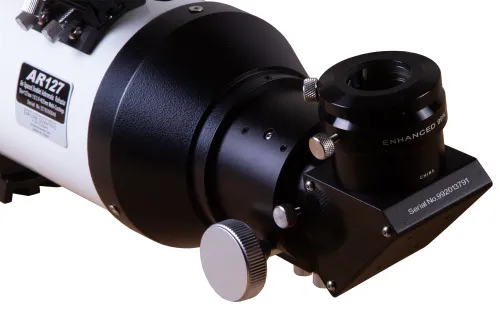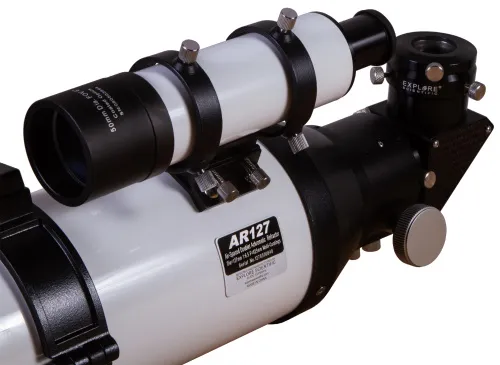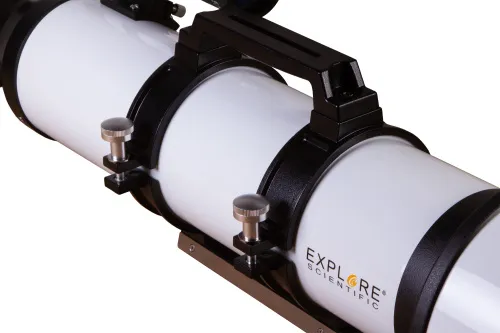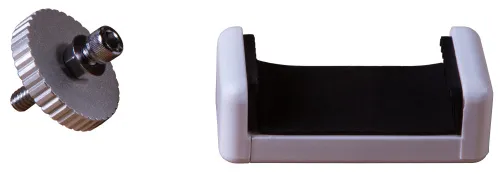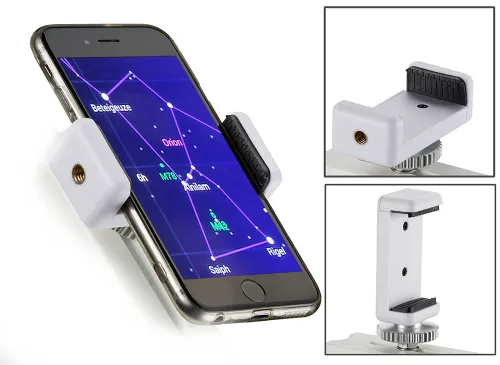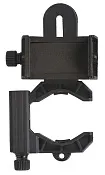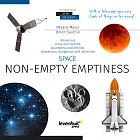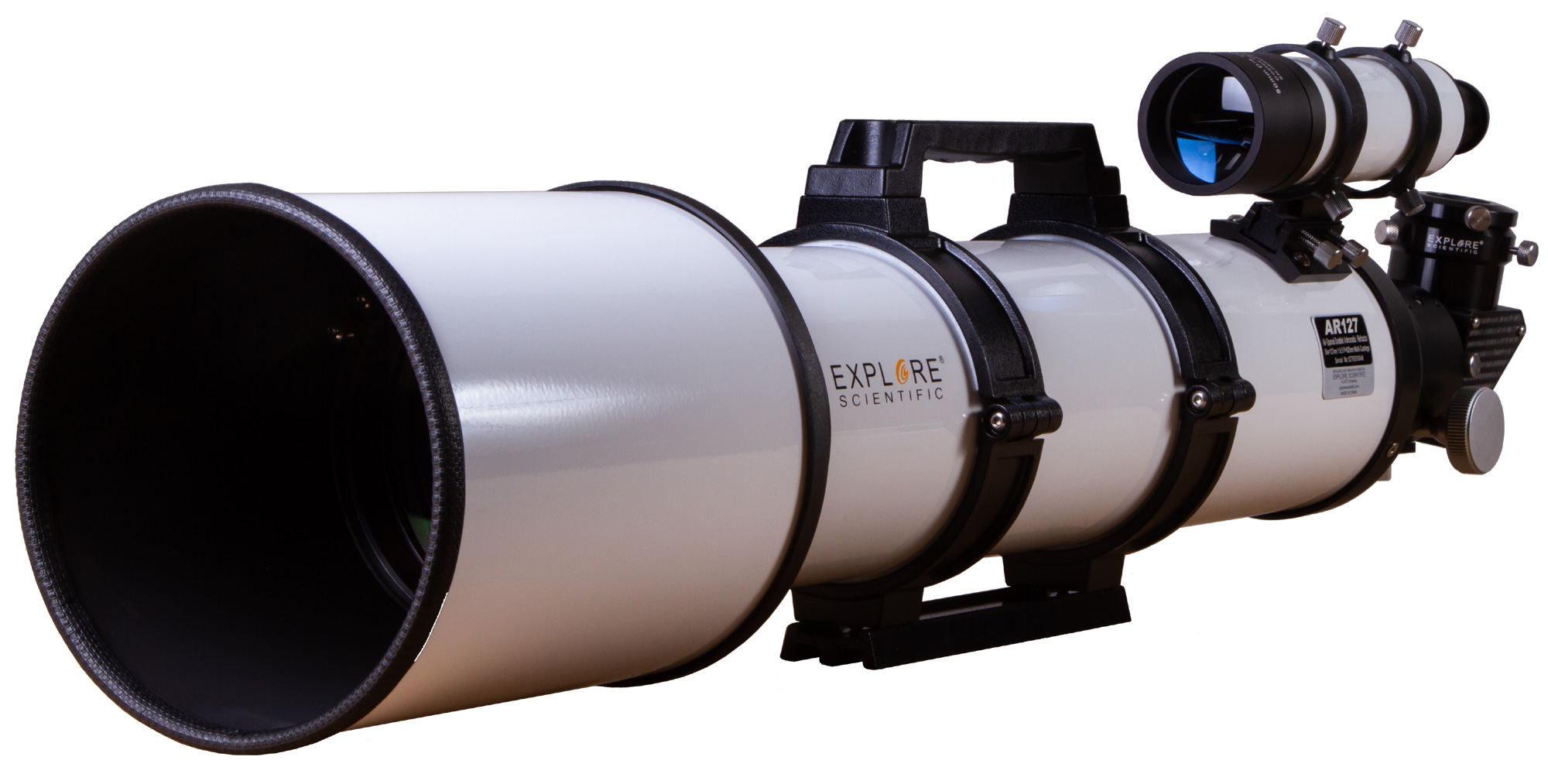Explore Scientific AR127 f/6.5 Air-Spaced Doublet OTA
Achromatic refractor. Objective lens diameter: 127mm. Focal length: 825mm
| Product ID | 71075 |
| Brand | Explore Scientific |
| Warranty | 2 years |
| EAN | 0753215774098 |
| Package size (LxWxH) | 28x115x24 cm |
| Shipping Weight | 9.92 kg |
The classic air-spaced, crown-and-flint, doublet achromatic refractor is reborn with the aim to produce superior-class optical figure in a short (f/6.5) focal length design with Explore Scientific Air-Spaced Doublet AR Series. These optics are an extreme value, produce stunning images of deep sky objects, double stars, planets, and the moon that are a small fraction of the price of comparable aperture apochromat refractors. Finally one can own a diffraction-limited high quality refractor for a relatively modest investment.
Designed to handle the rigors of public star parties and educational outreach, the Explore Scientific AR Series has standard hardware which includes a precision two-speed focuser, a 99% dielectric-coated 2-inch diagonal, and an 8x50 finder scope. You can be confident that the quality and construction of these telescopes will allow heavy use for many years. Fully Multi-Coated Optics The optics in their collimatable lens cell are fully multi-coated to eliminate light scatter and maintain image contrast. We precision collimate every Explore Scientific telescope at our factory to give optimum performance. Although you may never need to adjust optical alignment, the AR Series allows for collimating the lens set should the telescope ever require it. Contrast is further enhanced with multiple baffles that mask and deflect unwanted stray light.
Deluxe Two-Speed Focuser The Explore Scientific Air-Spaced Doublet AR Series telescopes include a precision 2-inch, two-speed as standard equipment. The eyepiece holder uses a compression ring to prevent the eyepiece or camera barrel from scoring. Perfect focus is easily achieved with the Explore Scientific Two-Speed Focuser On those prestine nights of steady seeing, Saturn's Rings can forever affect the hearts and minds of almost anyone who lays eyes on them. It's nights like these that astronomers like to set up their refractors and push the magnification to the limits, not only to see the magnificence of the planet at greater scale but to really test the optical and mechanical quality of the telescope. Many telescopes are only supplied with a standard single-speed focuser, you will find that a tiny nudge will throw out focus and turn your night into one of frustration.
So we included as standard equipment, on all Explore Scientific AR Series, a ten-to-one, two-speed Crayford-style precision focuser with tension adjustment and lock to obtain and hold perfect focus. We think you'll agree that such precision is worth it. Universal Mounting Plate The Universal Mounting Plate of the AR Series Telescopes The Universal Adjustable Mounting Plate of the AR 127 fits on many popular equatorial and Altaz mounts, including mounts supplied by Explore Scientific, Vixen, and Meade LXD55/75. Instead of using a cast metal part, Explore Scientific's Universal Mounting Plate is made from extruded aluminum for added strength, it is afterall what secures your telescope to the mount. We also include adjustment screws and locking bolts to allow adjustments to position the angle of the telescope when it is placed on its mount, an important feature when using an equatorial mount.
Viewing Comfort and the Preservation of Precious Light The Two-Inch Dielectric Diagonal includes a 1.25" eyepiece holder adapter and dust covers to protect the mirror.
The purpose of a diagonal is to securely hold your eyepiece and to give you a comfortable viewing angle. Provided as standard equipment, Explore Scientific's Two Inch Dielectric Diagonal incorporates a light-weight, one-piece diagonal body that securely cradles the precision polished diagonal flat mirror, insuring precision alignment. Ultra-high reflective coatings (99% reflective) composed of multiple thin layers of dielectric material delivers maximum light output. Both 2" and 1.25" eyepiece holders use compression rings instead of a simple set-screw to more securely hold your valued eyepiece (or imaging device) and to minimize scoring of eyepiece barrels. You can thread standard 48mm filters into the barrel. Provided as standard equipment, Explore Scientific's Two Inch Diagonal incorporates a light-weight, one-piece diagonal body that securely cradles the precision polished diagonal flat mirror, insuring precision alignment.
8x50 Finder Scope The Explore Scientific 8x50 Finder Scope provides a true field of view of 6°. Its coated optics provide a bright high-resolution image so that many faint stars and nebulosity can be detected for precise aiming. 8x50 Finder Scope with its Six Point Adjustable Finder Bracket. The front objective can be custom focused to provide a sharp image every time.
Features:
- Optical design: Air-Spaced Doublet achromatic refractor
- Clear aperture: 127mm
- Focal length: 825mm
- Focal ratio: f/6.5
- Resolving power: 0.9 arc seconds
- Coatings: fully multi-coated
- Limiting stellar magnitude: 13
- Focuser: two-speed Crayford-style, w/adjustable tension and lock
- Finder Scope: 8x50 straight; adjustable objective focus; dual-ring, six-point, bracket w/quick release shoe
- Cradle/saddle plate: dual ring style – fits Explore Scientific mounts; Celestron mounts; Vixen mounts; Meade LXD55/75 mounts
- Tube diameter: 5.13" – 130.4mm
- Tube length: 34" – 863.6mm
- Dew cap diameter: 176mm
- Tube construction: aluminum; stainless steel
The kit includes:
- Optical tube with removable dew-shield
- Front and rear dust covers
- Cradle rings with handle and univsersal saddle plate
- Two-speed focuser 2.0" I.D.
- 8x50 Finderscope with six point adjustable bracket
- 2.0" 99% reflective mirror diagonal with 1.25" adapter
| Product ID | 71075 |
| Brand | Explore Scientific |
| Warranty | 2 years |
| EAN | 0753215774098 |
| Package size (LxWxH) | 28x115x24 cm |
| Shipping Weight | 9.92 kg |
| Optical design | refractor |
| Optical scheme | achromat |
| Optics coating | fully multi-coated |
| Objective lens diameter (aperture), mm | 127 |
| Focal length, mm | 825 |
| Highest practical power, x | 254 |
| Aperture ratio | f/6.5 |
| Resolution threshold, arcseconds | 1 |
| Limiting stellar magnitude | 13 |
| Eyepiece barrel diameter, in | 1.25/2 |
| Finderscope | optical, 8x50 |
| Focuser | 2", Crayford, 2-speed (1:10) |
| Optical tube mounting mode | fastening rings |
| Dovetail mount | ✓ |
| Optical tube material | aluminum |
| Optical tube dimensions, mm | 131x864 |
| User level | experienced users, professionals |
| Observed object | planets of the Solar System and deep-sky objects |
Convenient diagrams that describe how to install additional accessories on refractors and catadioptric telescopes
Find out how to assemble a telescope on an example of the Levenhuk Skyline 90x900 EQ telescope
This short guide will help you avoid typical mistakes and learn more about telescope and mounting types
The basics of astronomical observations for beginners
In this article we have gathered answers to some of the most frequently asked questions about telescopes
How telescopes work?
You can actually perform observations from your balcony!
All about telescope sizes, types, magnification, and mounts
Learn how to set up and use the telescope properly
Astronomy in light-polluted skies. Find out what you can observe in the city
Read an interesting comprehensive article on telescopes for little astronomers
Celestial objects you can observe with telescopes of different apertures
Colored and vivid images of galaxies, planets and star clusters entrance everyone who is fascinated by boundless space
Find an interesting review on the history of the changes to a refracting telescope
To make the process of choosing a telescope easier, we will tell you about the characteristics of the most popular types of telescopes today
Learn everything you need to know about refractor telescopes to make the right choice

